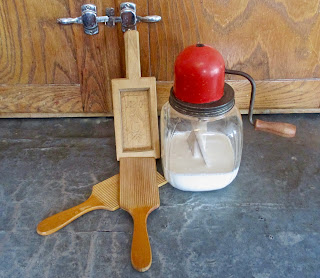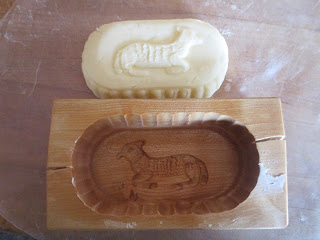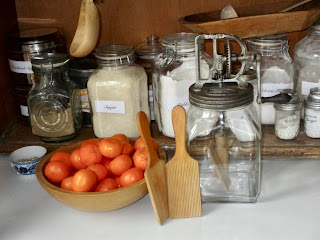Butter!
"Fat gives things flavor." - Julia Child
Butter is an amazing substance. In addition to cheese, it's about one of the nicest things one can do to preserve an abundance of milk. I know people who try not to eat butter, or think they shouldn't eat butter, but I know very few people who don't love butter. Even if they're not actually eating butter, they're eating something that tastes as much like butter as possible. We humans just love butter. Whether churned from goat's milk, sheep's milk, yak or cow's milk, butter has been with us for thousands of years. The National Museum of Ireland has in its collection a keg of butter which dates from 360 - 200 BCE which was found in a bog!
Some years ago I bought a butter churn. I'll bet the image that comes to your mind immediately looks something like this. Yes, this style of butter churn was around for hundreds of years, but it uses at least a gallon or so of cream at a time, and it makes a lot of butter. Pounds and pounds of the stuff. Later churns were an improvement on the older type, but they also made far more butter than a small family could use.
Around the turn of the Twentieth Century, however, someone figured out that making butter could be done on a much smaller, family sized scale, and the butter churn was redesigned based on a glass container with paddles inside which were turned by a hand crank. This kind of churn required far less cream, made a lot less mess, and was much faster and easier to work with than plunging away, up and down, with a dasher (the stick thing you see in the middle of the churn above). It was also much easier to clean and store. Most of these glass, hand-cranked churns are called Dazey churns.
I bought one of these Dazey churns about 10 years ago. It probably dates from about 1930, and I'd used it a few times for demonstrations, but it had languished on a shelf for a number of years. You see, living in Wisconsin, The Dairy State, I have evidently been under the misapprehension that it was possible to get fresh, raw cream from a local dairy rather than buying pasteurized cream at a local supermarket. Alas, this is far more difficult than one might expect. There are laws in place that prohibit sales of raw milk in the state, and woe betide the farmer who attempts it. Even though there is a provision in the law that permits "incidental sales" at the farm, I have yet to find a single dairy farmer who is willing to risk it. It's almost a superstition, and the mere mention of it will have a farmer edging away from you nervously. Thinking it was the raw milk angle that was the problem, I thought I would inquire about pasteurized cream instead. Nope. I can't seem to get pasteurized cream from a local farm, either. There is one cheesemaker who sells cream, but only to select customers who were "grandfathered in". Alas, I am not among the favored "grandparents".
I kept waiting and hoping to find that one, magical source of direct-from-the-farm cream, but I finally gave it up and decided that butter making would have to proceed without farm-to-table cream. I bought a couple of pints of heavy whipping cream at our local market, got the churn down from the top of the tea hutch, washed it up carefully inside and out, and remembered the pleasure of making homemade butter. It has now become a regular part of what I do.
Here's how to do it:
First, make sure all your butter making items are scrupulously clean. Butter will go rancid quickly if the items used to make it are at all dirty. Scalding water can be used on any wood items. One butter maker recommends a solution of 50/50 white vinegar and water followed by a thorough rinse in hot water, and that seems to work well. I've also used salt in addition to scalding water on the wood items. Don't use bleach under any circumstances, and no antique churn or wooden molds or paddles should ever go into the dishwasher. Avoid detergents with strong perfumes as the smell will leach into the butter. I like to air dry my butter making items in my dish drying rack. I use a clean towel to start the drying process and let them finish up on the rack.
You need to buy heavy whipping cream to make butter. It has the highest fat content, and that's what butter is: fat. The temperature of the cream needs to be about 65 degrees, so you will need to take it out of the refrigerator and let it sit out to warm up a bit before you churn it. It will take about 20 minutes or so to churn the butter when your cream is at the proper temperature, and it will take forever if it's too cold. When I have read period novels or stories of early farm life, I used to wonder why women would set their churns near the fire in winter. I thought it was just a bit of romance thrown in by the writer, but one session with churning cream that was too cold made it obvious.
Fill your churn no more than two-thirds full of cream. The first stage of butter churning will create whipped cream which takes up a lot of room, so you don't want to overfill your churn. Screw the lid on firmly, and start cranking away. Sing a little song if you want.
I had thought that there would be loads of butter making songs - something to do to pass the time while plunging that dasher up and down in the churn - or, in this case, cranking away at the handle - but I couldn't find as many as I had thought there would be.
There is one churning song from eastern Kentucky sung to the tune of The Farmer in the Dell:
Churn churn, churn, this is churning day,
'Til the golden butter comes, the dasher must not stay.
Pat pat, pat, make it smooth and round,
Now the golden butter’s done, won’t you buy a pound?
The churning song I know goes like this:
Come butter come. Come butter come.
Peter's standing at the gate waiting for a butter cake.
Come butter come.
I never knew the tune, though. I recently found a recording of this song sung by a 74 year old grandmother while churning butter. https://www.youtube.com/watch?v=nHTrxmyJHBY. The slosh of the churn as she sings is wonderful.
And if you enjoy Irish fingerpicking guitar, there is a wonderful jig called "Hag at the Churn" played by Jean Banwarth that you can listen to https://www.youtube.com/watch?v=yai6wjmTZOI while you are churning away.
The first thing that is going to happen in your churn is whipped cream. Yum. But to get butter, you're going to have to keep cranking. Get your spouse or the kids to go at it awhile; you'll get there. When it starts to get stiff and harder to crank, butter is on it's way. Pretty soon, you'll start to hear sloshing: this is when the butter solids start to separate from the liquid. You'll start to see the some of the buttermilk splashing against the inside of the churn. If you take the lid off and look at the butter at this point, it will look like little grains. Put the lid back on and keep at it. When the buttermilk runs down the side of the jar, and when you can see that there is a lump of butter around the paddles and the buttermilk flows easily around it if you tip the churn, then it's ready.
Now comes the fun and messy part. Get your butter paddles (those flat wooden things that look like, well, paddles) ready and have your salt ready in a little dish (about 1/8 tsp. per pound of butter) that you can get to with buttery hands. The salt helps to preserve the butter, and it doesn't take much, but you can leave it out if you prefer. I find that it enhances the flavor and is not nearly as salty as commercial butter. You'll want a surface of some kind to work the butter on. I have a large, marble cutting board that keeps the butter nice and cold.
Pour the contents of the churn into a strainer that is suspended over a bowl. The liquid in the bowl is buttermilk, and you can use it for all kinds of things. It's different from the cultured buttermilk that you buy at the store, but it's just as useful. Don't throw it out.
Take the strainer to the sink and rinse the butter in ice cold water, mashing it up a bit as you do so to start releasing the excess buttermilk. I've found it works well for me to drop the butter in the strainer into a large basin of cold water, work the butter around, then dump it back into the strainer and refill the basin with fresh, cold water so I can do it again. It takes about three washings before the water runs clear.
Now take your butter lump and put it onto your work surface. Bash the butter about rather like kneading bread to get the last of the buttermilk out, squeezing it and pressing it with the paddles. Sprinkle the salt on, and knead it in with the paddles to incorporate it into the butter and press out the last of the buttermilk. Give it a good whack or two, flip it over, and do it again. There's a satisfying smack as the butter paddles work away.
The curved paddles in this photo are Norwegian. The flat ones in the photo above are English.
Shape your butter into the usual rectangular shape using the paddles, or you can press it into a butter mold that has been soaked in cold water. Chill your butter, then drop it out onto a plate. Your family will gasp at your artistry and will attack the butter with gusto and hunks of warm bread.
If you're interested in making butter but you don't have a churn, you can experiment with shaking it up in a large canning jar and using a couple of spatulas or wooden spoons to work your butter. You can shape it into little balls with a melon baller or shape it into any form you like, chill it a little, and use a cookie press to press a design into the butter. You can add herbs like chives or basil or even lavender. Plain or fancy, home churned butter is in a league of its own.
If you decide to go all the way and get a churn, you can find them in antique stores. I've tried one of the newer churns, and the gears just don't hold up, so go for the antique/vintage churns. Check for cracks and chips, and make sure the lid comes off and the handle turns. You'll need to give it a good scrubbing and oil the gears with vegetable oil. You can find wooden butter paddles and butter molds online through Lehman's, a store that sells to the Amish community as well as low-tech folk and homesteaders.
Churning your own butter is a delicious way to experience a part of Victorian living that would have been commonplace in many rural households. And now, if you'll excuse me, I feel a sudden urge to go toast some bread and smear fresh butter on it. Mmmmmmm...











